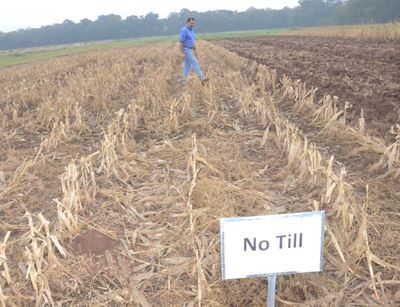Soybean Study Evaluates Residue Control
ALEXANDRIA, LA.
LSU AgCenter soybean specialist Ron Levy is conducting the first year of a study at the Dean Lee Research Station to find the balance between preparing an adequate seedbed and retaining organic matter left from the harvest.
Levy has a series of strip plots with crop residue management techniques, including:
• No till.
• No till that is flail mowed after harvest.
• A stale seedbed, plowed in the fall to be followed with a herbicide treatment prior to planting.
• Conventional tillage.
• Burning.

LSU AgCenter soybean specialist Ron Levy looks over a test of different methods of handling plant material left after harvest. Levy will plant soybeans into the test strips at the Dean Lee Research Station to determine any effects on yields.
Photo by Bruce Schultz
In the spring, the different tillage strips will be planted with the same soybean variety at a uniform seeding rate.
Burning may make planting easier than planting into crop residue, but burning harvested crop residue causes many problems, such as destroyed organic matter and increased soil erosion, Levy said. Fire also increases the potential for nutrients to leave a field in water runoff.
Previous crop residue can contribute soil nutrients and micronutrients to be used by successive crops with a potential value of $80 per acre.
“We’re trying to encourage growers not to burn because of the erosion and nutrient loss,” Levy said. “Leaving the residue on the soil increases the organic matter and reduces soil losses from erosion.”
Plant material left on the field after harvest also slows the movement of water out of a field, he said, but burning causes soil erosion and nitrogen loss.
“By leaving the residue on the soil surface, it reduces the amount of soil and nutrient losses because rain hitting the soil dislodges particles and puts them into solution,” Levy said.
Conservation tillage can benefit producers by allowing them to plant earlier. With no tillage or fall tillage, fields are ready for planting when weather is favorable in early spring, Levy said.∆